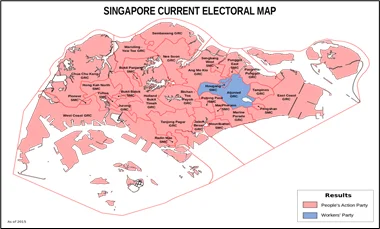Social stability– Singapore has always had a low crime rate and a stable government, therefore riots are unexpected. The most recent riot was the Little India Riot of 2013 that arose due to a traffic accident where a drunk migrant worker was killed when he was in the blind spot of a public bus. This resulted in the mass rallying of 400 migrant workers such that the Special Operations Command (SOC) had to intervene. This riot ultimately led severe ramifications such as restrictions on alcohol sale and setting up of private bus services for migrant workers.
Political stability – The government of Singapore has always has the support of the people as indicative through its political stability and absence of terrorism having a percentile rank of 99.52%. Though the nation mostly runs as a one-party system under the People’s Action Party (PAP), the system of proportional representation of parties in the Parliament indicate the needs of the people. Moreover, the laws of suppression of free expression and assembly help maintain political stability in the eyes of public opinion.
Religious Stability – Singapore is a secular state, thereby accepting of all communities, especially from the neighbouring countries. However, this was always not the case as suggested by the 1669 race riots between the Chinese and Malay communities for public recognition. Though the region is still predominantly Chinese, these riots resulted in the formation of a New Economic Policy allowing Malay access to public facilities and a quota representation in the government.
Government Priorities
1. A $4 billion package of stabilisation and support has been established by the government. In this slow-growth period, this package is intended to help workers stay employed.
2. In the midst of the COVID-19 crisis, employees will receive a cash grant to offset 8% of their wages for three months. The government will spend $1.3 billion on these benefits, which will benefit all enterprises and their employees.
3. As a means of assisting enterprises with cash flow, the government will rebate 25% of tax payable, up to $15,000 per enterprise, for the year of assessment (YA 2020). Tax payers will benefit from this, despite the government spending $4 million. Additionally, wage credit schemes for Singaporean workers will be enhanced.
4. Over the next three years, Singapore will set aside $8.3 billion to support its transformation and growth efforts. There are three main areas for this:
- Collaboration for mutual benefit
- Enhancing enterprise capabilities
- People development
5. Singapore’s start-up ecosystem is ranked in the top 15 for the global start-up ecosystem report. As part of deepening enterprise capabilities, the government will set aside an additional $300 million under the Entrepreneurs has invested in start-ups. In the next 10 years, the government plans to attract more than $800 million in private funding.
6. As part of the transformation and growth initiatives, businesses are offered the following two packages:
Enterprise Grow Package
1· Develop a business platform
2· Digital technology is being adopted more widely. Program to promote digital transformation for small and medium-sized businesses
3· Ensuring that more enterprises can access market readiness grants and expanding their entry into new markets
Enterprise Transform Package
1· To promote the next phase of growth for small and medium-sized enterprises, Enterprise Singapore will launch the Enterprise Leadership For Transformation programme.
2· 3,000 projects will be supported by the government through the Enterprise Development Grant


